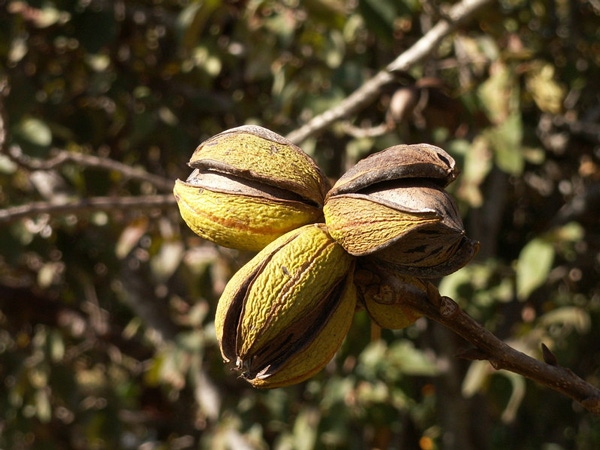May 24, 2011

Higher than normal temperatures, longtime drought conditions and recent rains are leading many Oklahoma growers to see increased numbers of a significant nut pest, the pecan nut casebearer.
“This is one of the most devastating nut-feeding insects that occur in pecans,” said Phil Mulder, Oklahoma State University Cooperative Extension entomologist and head of the OSU Department of Entomology and Plant Pathology.Oklahoma is the fifth-largest pecan-producing state in the nation.
In Oklahoma, adult casebearer moths deposit eggs on the tips of nuts shortly after tree pollination, usually during late May or early June. After hatching, one larvae can burrow into nuts and may damage an entire cluster or multiple clusters.
“The primary means of controlling this insect is the use of a well-timed application of insecticide based on infestation levels from each individual orchard,” Mulder said.
With pecan nut casebearer activity being largely dependent on temperature, trap catches are showing little difference in activity from south to north as would be expected and usual in most years.
Activity across the pecan belt can be viewed by accessing the pecan pages of the Pest Information Platform for Extension and Education website – often referred to simply as “ipmPIPE” – at http://pecan.ipmpipe.org on the Internet.
“The black-and-white markers are locations of volunteer producers who are reporting casebearer captures in pheromone traps,” said Doug Maxey, Okmulgee County Extension director and agricultural educator. “When trap captures are received the marker turns green.”
When the decision window opens – which is when a producer can go to the orchard and make a decision on whether or not to apply a treatment – the marker turns yellow. When the decision window closes, the marker turns red.
“For producers who are running their own traps, you can make a prediction on egg lay for your orchard from your trap catch data,” Maxey said.
At http://pecan.ipmpipe.org, go to maps and pecan nut casebearer (PNC) forecast. The grower should click on the warning and then place a marker on his or her orchard site with a right click of the mouse. Next, enter the date of the orchard’s first significant moth catch, i.e. the first date of two consecutive collection nights.
“The program will provide the producer with a table and a graph of predicted percent completion of oviposition, which is simply a scientific term for the laying of eggs,” Mulder said. “The best time to begin scouting is when 25 percent oviposition is predicted.”
It is recommended that producers examine 310 pecan clusters for the presence of pecan nut casebearer eggs or damage, and continue to scout during the critical four-day window that will take place 12 days to 16 days after the first capture of adult moths. It is also a good management practice to estimate crop load at this time.
“This is helpful in determining the need for treatment and justifying the expense,” Mulder said. “Products recommended for pecan nut casebearer control include softer products such as Intrepid, Confirm and Bacillus thuringiensis (Bt) insecticides that are gentler on beneficial organisms and safer for the environment.”
There is a searchable insecticide and fungicide data base in the “Tool Box” link located on the left side of the http://pecan.ipmpipe.org homepage. The site allows growers to search by active ingredient, pest, company and organic certification. A producer can also examine the entire list of labeled pecan insecticides for any and all pests.
You May Also Like




